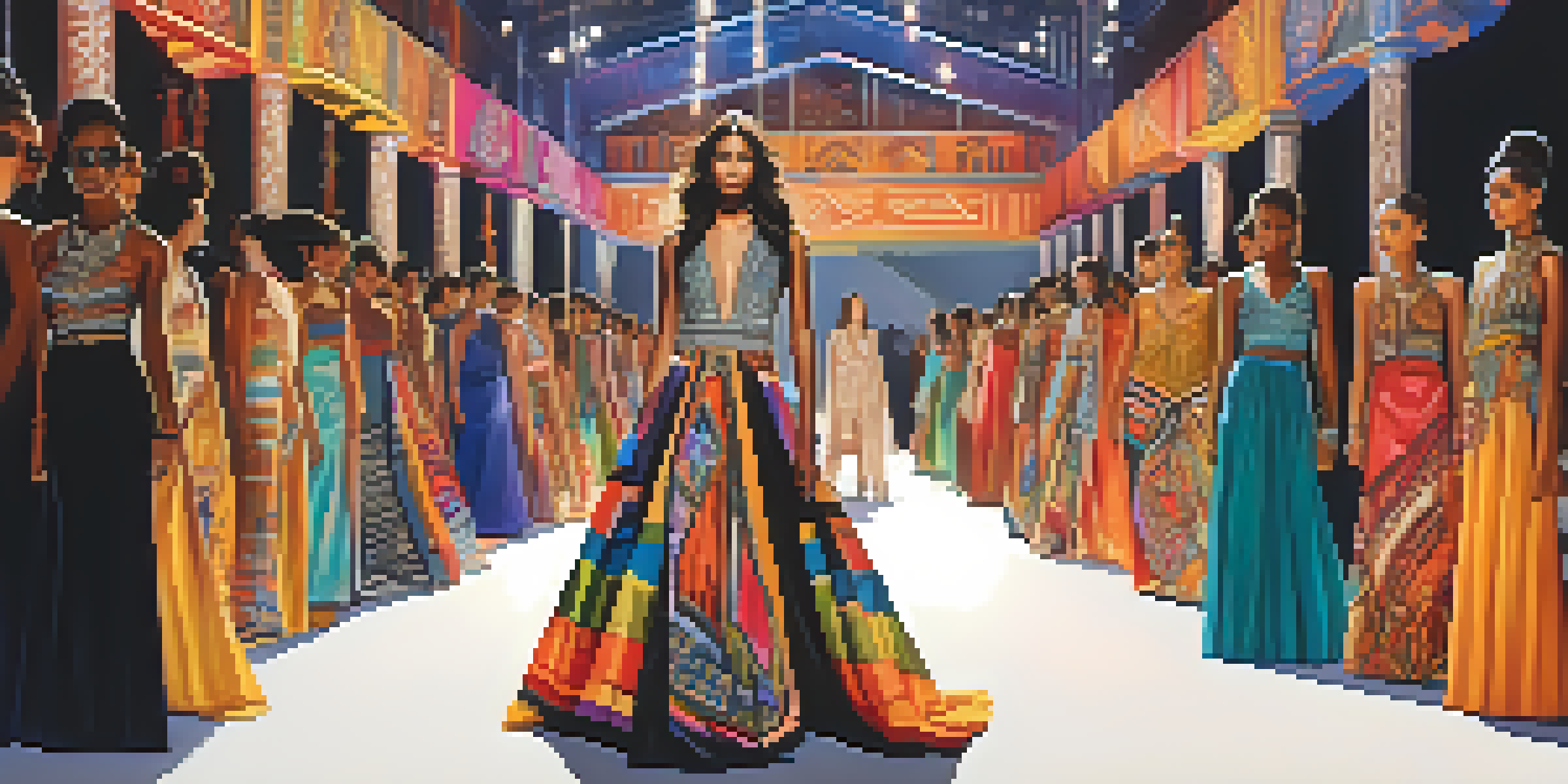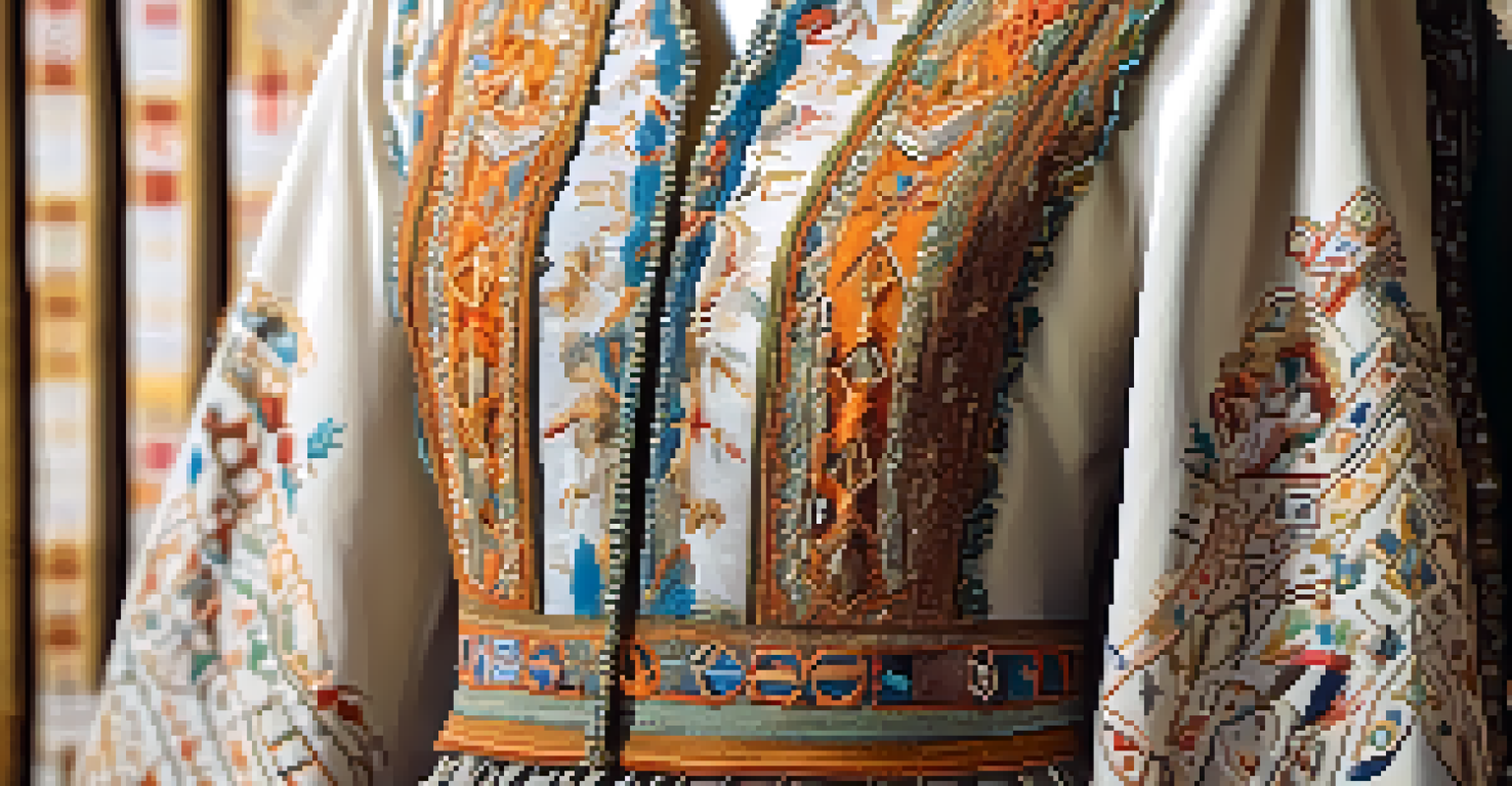Cultural Symbols in Fashion: An Artistic Perspective

Understanding Cultural Symbols in Fashion
Cultural symbols are powerful representations of a community's identity, beliefs, and values. In fashion, these symbols can be woven into the fabric of garments, making a bold statement about heritage and personal style. For instance, the use of tribal patterns in contemporary clothing can evoke a sense of pride and connection to one's roots.
Fashion is the armor to survive the reality of everyday life.
These symbols often transcend mere aesthetics; they tell stories and convey messages. Designers who incorporate cultural motifs aim to honor their origins while appealing to a broader audience. This blend of tradition and modernity allows for a deeper appreciation of diverse cultures within the fashion industry.
However, it’s essential to approach these symbols with respect and understanding. Misrepresentation or appropriation can lead to controversy, highlighting the importance of cultural sensitivity in design. As fashion continues to evolve, the balance between artistic expression and cultural respect remains crucial.
The Role of Art in Fashion Design
Art and fashion have always been intertwined, with designers often drawing inspiration from various artistic movements. From the bold colors of Abstract Expressionism to the intricate patterns of Art Nouveau, these influences can be seen in collections across the globe. By merging artistic elements with fashion, designers create wearable pieces that resonate on multiple levels.

For example, the work of designers like Yves Saint Laurent, who famously incorporated the aesthetics of painting into his collections, showcases how art can elevate fashion. Each piece becomes a canvas, inviting wearers to express their individuality while celebrating artistic heritage. This approach not only enhances the visual appeal but also adds layers of meaning to the garments.
Cultural Symbols Enhance Fashion Identity
Incorporating cultural symbols into fashion allows designers to celebrate heritage while creating meaningful connections with diverse audiences.
Moreover, art-inspired fashion fosters a dialogue between different cultures and eras. By referencing historical art movements or iconic artists, designers can create a narrative that challenges societal norms and encourages self-expression. This fusion of art and fashion transforms clothing into a medium for storytelling.
Case Studies: Fashion Designers and Cultural Symbols
Several contemporary designers have successfully integrated cultural symbols into their work, creating meaningful connections with their audiences. Take, for instance, the designs of Stella Jean, who blends her Italian and Haitian heritage to craft vibrant, culturally-infused collections. Each piece not only reflects her identity but also invites conversation about multiculturalism in fashion.
Style is a way to say who you are without having to speak.
Similarly, the brand Kenzo often showcases bold prints inspired by Asian art and culture, making a statement on diversity and inclusion. By celebrating these cultural motifs, Kenzo not only honors its heritage but also engages a global audience, reinforcing the idea that fashion is a universal language.
These case studies illustrate how designers can navigate the fine line between inspiration and appropriation. By respecting the origins of cultural symbols and collaborating with communities, fashion can become a platform for dialogue and empowerment, rather than division.
Cultural Symbols: A Double-Edged Sword
While cultural symbols can enrich fashion, they can also lead to challenges. Misappropriation of cultural elements can result in backlash, as communities feel their identities are being exploited. This highlights the need for designers to engage in thorough research and dialogue with cultural representatives before incorporating symbols into their work.
Moreover, even well-intentioned designs can sometimes misinterpret the original meaning of symbols, leading to confusion or offense. A garment adorned with a sacred symbol may be seen as a fashion statement rather than a representation of cultural significance. This can dilute the symbol's impact and alienate communities that hold it dear.
Art and Fashion: A Creative Fusion
The interplay between art and fashion transforms garments into storytelling mediums, enriching the narrative of personal and cultural expression.
Thus, designers must approach cultural symbols with a critical eye and an open mind. By fostering genuine connections with communities and prioritizing education, the fashion industry can promote a more respectful and inclusive environment, where cultural symbols are celebrated rather than commodified.
Fashion as a Reflection of Social Change
Fashion often serves as a mirror to society, reflecting the values and beliefs of its time. As cultural symbols gain prominence in fashion, they can highlight social issues and promote awareness. For example, garments featuring indigenous designs can raise questions about cultural preservation and representation within the fashion world.
Moreover, the rise of sustainable fashion has encouraged designers to rethink their use of cultural symbols. By emphasizing ethical practices and honoring traditional craftsmanship, designers can showcase the beauty of cultural heritage while promoting social responsibility. This shift not only benefits communities but also resonates with consumers seeking more meaningful connections with the brands they support.
Ultimately, fashion's role as a vehicle for social change underscores the importance of cultural symbols. As designers embrace these elements with authenticity and respect, they can contribute to a more equitable and inclusive narrative within the industry.
Consumer Responsibility in Fashion Choices
As consumers, we wield significant power in the fashion industry through our purchasing decisions. Understanding the cultural significance of symbols in fashion can help us make more informed choices that support ethical practices. When we opt for brands that prioritize cultural authenticity and respect, we contribute to a more sustainable and equitable industry.
Moreover, consumers can advocate for greater transparency in fashion by asking questions about a brand's sourcing and design processes. By engaging with brands and demanding accountability, we can encourage a shift towards more respectful representations of cultural symbols. This not only benefits communities but also fosters a deeper appreciation for the stories behind our clothing.
Consumer Choices Shape Ethical Fashion
Consumers play a crucial role in promoting ethical practices by supporting brands that respect cultural authenticity and transparency.
Ultimately, the responsibility lies with both designers and consumers to uphold the values of cultural respect and inclusivity. By collaborating and engaging in meaningful conversations, we can create a fashion landscape that celebrates diversity and honors the rich tapestry of human experience.
The Future of Cultural Symbols in Fashion
The future of fashion lies in its ability to adapt and evolve while honoring cultural symbols. As the industry becomes more globalized, the blending of cultural influences is bound to continue. However, this evolution must be accompanied by a commitment to education and respect, ensuring that cultural symbols are not diluted or exploited.
Innovative technologies, such as digital fashion and virtual reality, also present new opportunities for cultural expression. Designers can experiment with virtual garments that showcase cultural motifs in unique ways, pushing the boundaries of creativity. This shift opens up exciting possibilities for storytelling and representation in fashion.

In conclusion, the future of cultural symbols in fashion holds immense potential for creativity and collaboration. By fostering a culture of respect and understanding, the fashion industry can become a vibrant platform for celebrating diversity and promoting social change.